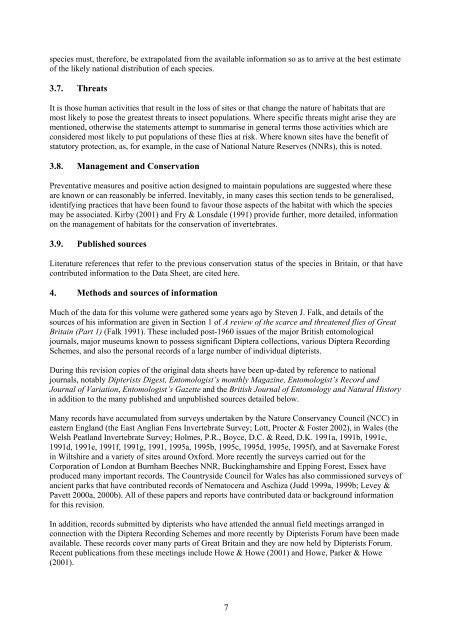Part 2: Nematocera and Aschiza not dealt with by Falk (1991) - JNCC
Part 2: Nematocera and Aschiza not dealt with by Falk (1991) - JNCC
Part 2: Nematocera and Aschiza not dealt with by Falk (1991) - JNCC
You also want an ePaper? Increase the reach of your titles
YUMPU automatically turns print PDFs into web optimized ePapers that Google loves.
species must, therefore, be extrapolated from the available information so as to arrive at the best estimate<br />
of the likely national distribution of each species.<br />
3.7. Threats<br />
It is those human activities that result in the loss of sites or that change the nature of habitats that are<br />
most likely to pose the greatest threats to insect populations. Where specific threats might arise they are<br />
mentioned, otherwise the statements attempt to summarise in general terms those activities which are<br />
considered most likely to put populations of these flies at risk. Where known sites have the benefit of<br />
statutory protection, as, for example, in the case of National Nature Reserves (NNRs), this is <strong>not</strong>ed.<br />
3.8. Management <strong>and</strong> Conservation<br />
Preventative measures <strong>and</strong> positive action designed to maintain populations are suggested where these<br />
are known or can reasonably be inferred. Inevitably, in many cases this section tends to be generalised,<br />
identifying practices that have been found to favour those aspects of the habitat <strong>with</strong> which the species<br />
may be associated. Kir<strong>by</strong> (2001) <strong>and</strong> Fry & Lonsdale (<strong>1991</strong>) provide further, more detailed, information<br />
on the management of habitats for the conservation of invertebrates.<br />
3.9. Published sources<br />
Literature references that refer to the previous conservation status of the species in Britain, or that have<br />
contributed information to the Data Sheet, are cited here.<br />
4. Methods <strong>and</strong> sources of information<br />
Much of the data for this volume were gathered some years ago <strong>by</strong> Steven J. <strong>Falk</strong>, <strong>and</strong> details of the<br />
sources of his information are given in Section 1 of A review of the scarce <strong>and</strong> threatened flies of Great<br />
Britain (<strong>Part</strong> 1) (<strong>Falk</strong> <strong>1991</strong>). These included post-1960 issues of the major British entomological<br />
journals, major museums known to possess significant Diptera collections, various Diptera Recording<br />
Schemes, <strong>and</strong> also the personal records of a large number of individual dipterists.<br />
During this revision copies of the original data sheets have been up-dated <strong>by</strong> reference to national<br />
journals, <strong>not</strong>ably Dipterists Digest, Entomologist’s monthly Magazine, Entomologist’s Record <strong>and</strong><br />
Journal of Variation, Entomologist’s Gazette <strong>and</strong> the British Journal of Entomology <strong>and</strong> Natural History<br />
in addition to the many published <strong>and</strong> unpublished sources detailed below.<br />
Many records have accumulated from surveys undertaken <strong>by</strong> the Nature Conservancy Council (NCC) in<br />
eastern Engl<strong>and</strong> (the East Anglian Fens Invertebrate Survey; Lott, Procter & Foster 2002), in Wales (the<br />
Welsh Peatl<strong>and</strong> Invertebrate Survey; Holmes, P.R., Boyce, D.C. & Reed, D.K. <strong>1991</strong>a, <strong>1991</strong>b, <strong>1991</strong>c,<br />
<strong>1991</strong>d, <strong>1991</strong>e, <strong>1991</strong>f, <strong>1991</strong>g, <strong>1991</strong>, 1995a, 1995b, 1995c, 1995d, 1995e, 1995f), <strong>and</strong> at Savernake Forest<br />
in Wiltshire <strong>and</strong> a variety of sites around Oxford. More recently the surveys carried out for the<br />
Corporation of London at Burnham Beeches NNR, Buckinghamshire <strong>and</strong> Epping Forest, Essex have<br />
produced many important records. The Countryside Council for Wales has also commissioned surveys of<br />
ancient parks that have contributed records of <strong>Nematocera</strong> <strong>and</strong> <strong>Aschiza</strong> (Judd 1999a, 1999b; Levey &<br />
Pavett 2000a, 2000b). All of these papers <strong>and</strong> reports have contributed data or background information<br />
for this revision.<br />
In addition, records submitted <strong>by</strong> dipterists who have attended the annual field meetings arranged in<br />
connection <strong>with</strong> the Diptera Recording Schemes <strong>and</strong> more recently <strong>by</strong> Dipterists Forum have been made<br />
available. These records cover many parts of Great Britain <strong>and</strong> they are now held <strong>by</strong> Dipterists Forum.<br />
Recent publications from these meetings include Howe & Howe (2001) <strong>and</strong> Howe, Parker & Howe<br />
(2001).<br />
7
















